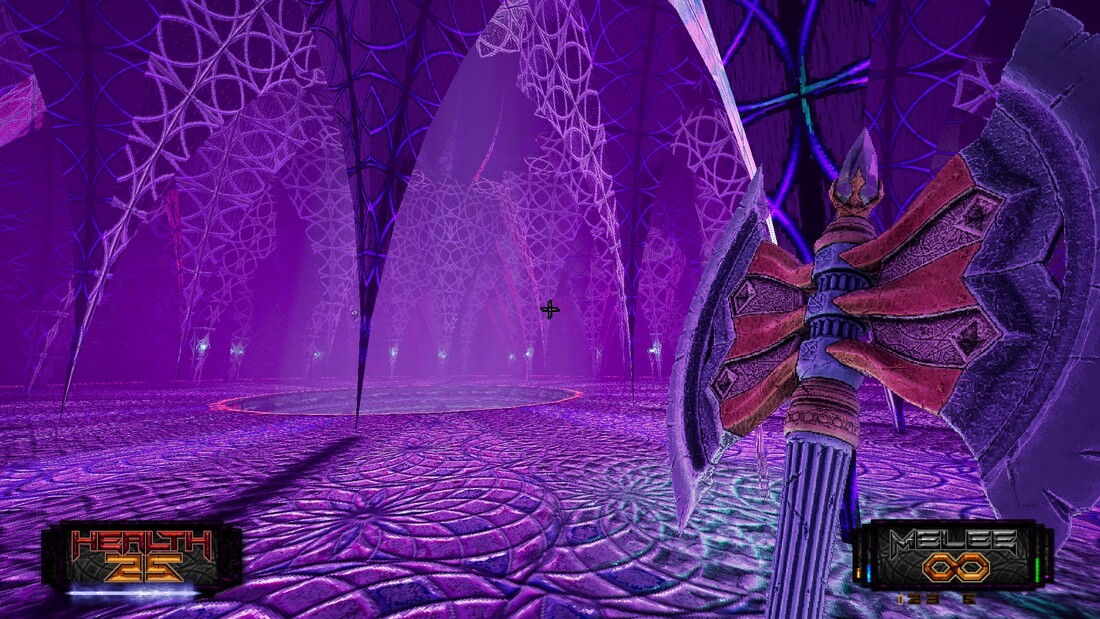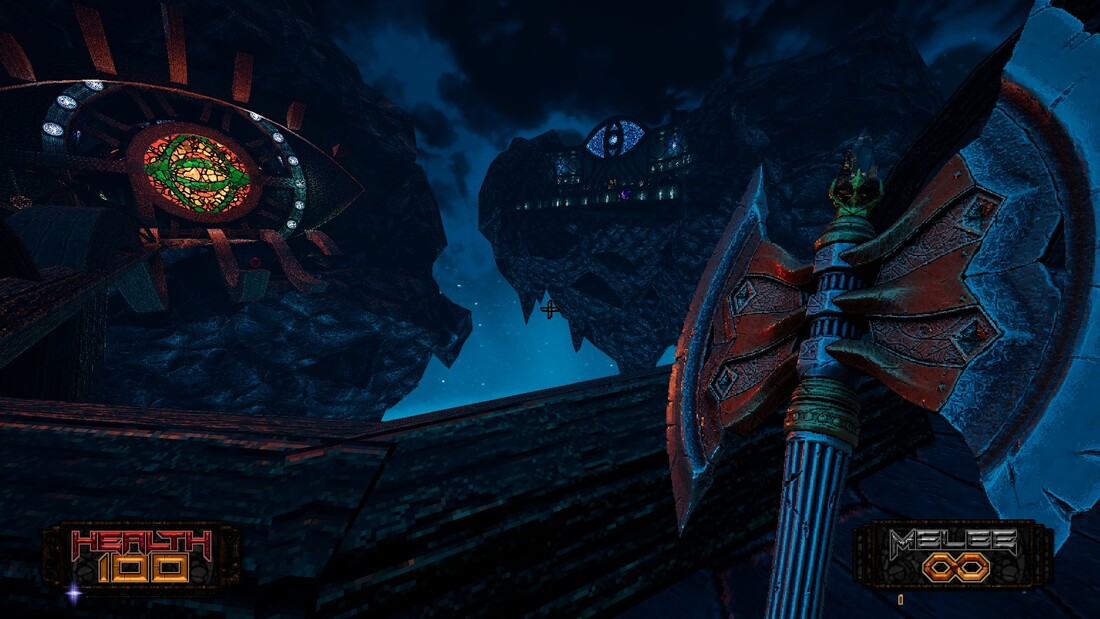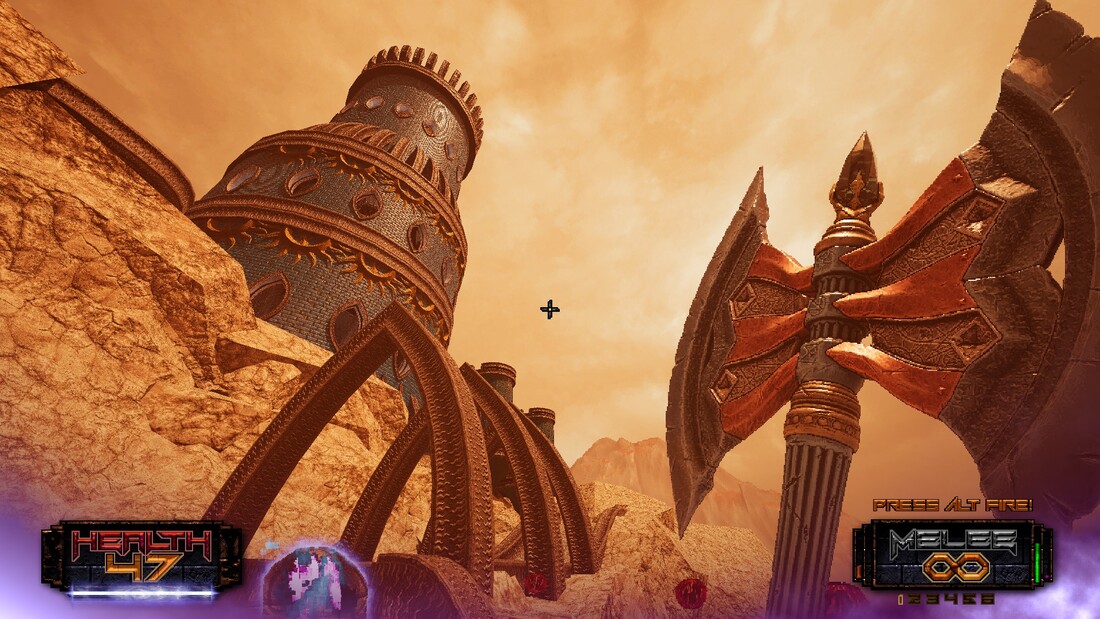|
Nothing looks quite like Amid Evil. Released from the murky ambiguity of Early Access into the sunlit uplands of actual completion in 2019, the fantasy shooter by developer Indefatigable has a genuinely unique aesthetic. Even moreso than its eminently solid gameplay, it is the visuals and level design of Amid Evil which elevate the game into being one of the best examples in the recent retro shooter boom.
Fantasy shooters have always been few and far between, and this means that Amid Evil is condemned to lazy comparisons with Raven Software’s games Heretic (1994) and Hexen (1996). Indefatigable’s game deserves better than to be categorised with these shooters, which have dated poorly and which did little more than port Doom into a hackneyed high fantasy setting. That’s not to say that Amid Evil has particularly groundbreaking gameplay itself. Its movement and weapons in particular will be familiar to anyone with a cursory experience of ‘90s shooters. The game is broken up into seven episodes, playable in any order as was standard for a number of games from that era. The story, too, is barely there - the player takes on the role of the nameless “Champion”, and is tasked with cleansing seven realms of the evil that has corrupted and subverted them. It's the way the developers built these worlds that gives Amid Evil the touch of greatness.
The technical underpinnings of Amid Evil play some role in its visual distinctiveness. Like Dusk (2018), the previous shooter published by leading lights of the genre New Blood, Amid Evil is built on a modern engine but carefully crafted to appear like a product of the ‘90s. While Dusk runs on indie favourite the Unity engine, Amid Evil uses Unreal Engine 4. In order to fuse old and new sensibilities, the developers employed a number of unusual approaches - notably the use of normal-mapped sprites for weapons, which help make the game look immediately distinctive.
Another building block in the game’s visual uniqueness is its use of colour. A number of recent retro shooters have employed a broader palette to help counter the tiresome greyness of a lot of modern military shooters, and Amid Evil is a part of this trend. While the seven episodes each tend to emphasise a particular colour, there is extremely skilful use of colour variety even within individual levels. In addition to graphics pipelines and colour palettes, another thing which Indefatigable used intelligently is the humblest building blocks of FPS design: shapes.
“Corridor shooter” is a term that long ago entered the classic FPS lexicon. In one sense it implies linearity, the feeling of being led down a predictable path by level design and denied the chance to explore freely. It summons up the image of early FPS games, particularly Wolfenstein 3D (1992), in which - due to technical restrictions - corridors were one of the only practical forms of level geometry. It’s worth remembering that for years, shooters were not truly three-dimensional and that the first game to feature curved surfaces was Quake III: Arena in 1999.
Amid Evil consciously works to use more varied, distinctive and dynamic shapes in its level design - something that even many modern games have failed to do. The advent of modern graphics engines has only rarely encouraged real experimentation; all too often, it has simply been used to render drab locations like office buildings and city streets more convincingly. Conversely, Amid Evil uses a succession of arcane temples on fantasy planes of existence for its settings. This frees up the developers to explore the potential of curves, spheres, diagonal lines, moving geometry, and all manner of other structural details that would sometimes be impractical or impossible in the real world. In videogames, spaces need not operate using the same parameters as reality and Amid Evil explores this with enthusiasm.
Robert A. Heinlein’s 1942 sci-fi novel Beyond this Horizon contains a well-known phrase: “the door dilated”. It’s a signal, in just a few words, that the world of the story’s setting operates very differently from our own. In Amid Evil, doors might not dilate but in different realms they open in several different ways, reflecting the flexibility of objects in Unreal Engine 4 and in the imaginations of the developers. Lifts, too, operate differently. Some move directly up and down, but others rotate around in dynamic arcs, or move on both the X and Y axes. The game may have very little in the way of story, but these details summon up intriguingly alien worlds just as effectively as the blood-crazed monsters that inhabit them - be they rogue machines or worshippers of the moon.
Another example is the game’s use of water. In many older games, water represents the exact opposite of free exploration within an environment - coming into contact with it means death, often instantaneously. In Amid Evil, water is a major element of level design in more than of the episodes. The Champion can breathe underwater indefinitely, which encourages exploration under the surface. Sometimes, the water level needs to be raised in order to swim up to reach previously inaccessible areas. In other cases, the unique physical laws that govern the realms mean that spherical anti-bubbles of water float without means of support. The player can swim and jump from one to another, gradually increasing height until the next area is reached. At one point, almost an entire boss battle takes place in one of these suspended spheres. What matters most, and where Amid Evil really shines, is how all of these adventurous individual elements are brought together into actual levels. Without a doubt, Indefatigable designed for their game some of the most impressive FPS levels of recent years. Each of the seven episodes has its own highlights. For example, “Tower of Light” is the centrepiece of Episode 4, the Solar Solstice. This region is inhabited by a corrupted sun cult, now obsessed with destroying the denizens of a moon cult that inhabit the setting of Episode 1.
“Tower of Light” is a mixture of outdoor and indoor spaces, often a key to creating pleasing spaces to fight within. The outer area is explored first, a series of yards that surround the formidable tower which looms above. The bright light used here is a stark contrast with other parts of the game, such as Episode 6 which takes place entirely at night. It’s inside the tower that the level design shines brightest, however. At one point, a switch causes a series of stone rings to rearrange themselves into a magic tunnel permitting access to the floor above - a good example of Amid Evil’s moving geometry. In development terms, this is clearly so much more complex than an ordinary lift, but far more rewarding for the player. Circular lifts can be found above, as can a pair of flight powerups, which vary the methods used to reach the top of the tower, where a boss awaits in the final level of the episode. Throughout, circles and sun symbols are visible, the unifying motif of this particular set of levels.
At its frequent best, Amid Evil recaptures the sense of adventure and experimentation that was found in the best FPS games of the 1990s. While the game’s visuals are excellent, they never overwhelm the keen sense of spatial design - it’s clearly crucial to the developers that levels are as enjoyable to move and fight in as they are to look at. The gameplay may be more solid than it is groundbreaking, but with its seven diverse and fascinating worlds Amid Evil easily places itself within the hall of fame when it comes to shooters that seek to revive, and build upon, the glory days of the FPS. That is definitely an achievement worth championing.
0 Comments
Your comment will be posted after it is approved.
Leave a Reply. |
About
Exploring classic science fiction, with a focus on the 1950s to the 1990s. Also contributing to Entertainium, where I regularly review new games. Categories
All
|



